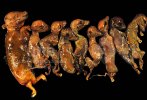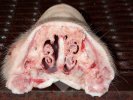Porcine cytomegalovirus
Cytomegalovirus is common and its consequences are often insignificant; it is characterized by rhinitis which causes sneezing.
Alternative names: Porcine cytomegalovirus infection, PCMV, inclusion bodies rhinitis
Information
Cytomegalovirus is a herpes virus found in all body tissue including the snout of newborn piglets which produces inflammation (rhinitis). PCMV is present throughout the world and exists in most, if not all, swine populations. Most infections are subclinical and clinical disease is rare. Serology performed in the UK, for example, indicates that over 90% of farms have been exposed to the infection.
Rhinitis caused by this virus is rare and occurs mostly in newborn piglets and in the nursery. It is not related to atrophic rhinitis caused by Toxigenic Pasteurella multocida and Bordetella bronchiseptica. On most farms the infection level is very low; it causes sporadic, mild sneezes with no major effect on the health of the pig.
Symptoms
Nursing and transition piglets
- Rhinitis in newborn piglets can be severe enough to cause nasal hemorrhage.
- On farms where PCMV is endemic the only symptom is mild sneezes in nursing and weaned piglets.
Fattening stage
- Not seen.
Sows
- Clinical signs are observed only if PCMV infects a sow for the first time when she is at the end of gestation.
- Fetal deaths.
- Mummified fetuses.
- Stillbirths.
- Weak piglets.
- Slight fever.
- Lack of appetite.
- Nasal hemorrhage.
Causes / Contributing Factors
- The virus is excreted by nasal and ocular discharges, from urine and farrowing fluids.
- Poor environmental conditions.
- Temperature fluctuations might predispose animals.
- Dust.
- Continuously inhabited facilities.
Diagnosis
It can be confirmed by serology, fluorescence antibody tests, and demonstrating the presence of inclusion bodies in histological sections of tissue.
The disease can be confused with atrophic rhinitis or infection of the snout due to Bordetella, however the effects do not last long and do not produce progressive atrophy or snout distortion.
Using nasal swabs can confirm the presence of the virus by means of PCR. To confirm rhinitis, histopathology from nasal turbinates is required, demonstrating the presence of inclusion bodies.
Control/Prevention
- Unneeded.
Atlas of pathology
See images in the Altlas related to Porcine cytomegalovirus




